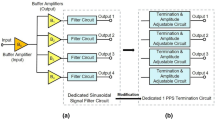Abstract
The measurement of time, or rather of time intervals, plays an important role in a variety of experimental methods used in nuclear physics and in its applications in chemistry. The function of a timing circuit is to determine the length of a time interval that is specified by two electric pulses, a “start” and a “stop” pulse.
Access this chapter
Tax calculation will be finalised at checkout
Purchases are for personal use only
Preview
Unable to display preview. Download preview PDF.
Similar content being viewed by others
References and Notes
E. Kowalski, Nuclear Electronics, Springer, Berlin (1970). A state-of-the-art book containing many references to original articles. See also L. J. Herbst, Electronics for Nuclear Particle Analysis, Oxford University Press, Oxford (1970).
R. E. Bell, Comparison of leading-edge and crossover timing in coincidence measurements, Nucl Instr. Meth. 42:211 (1966).
P. R. Orman, A synchronizing discriminator for scintillation counter pulses, Nucl. Instr. Meth. 21:121 (1963). Describes zero-crossover detection with a tunnel diode. See also D. L. Wieber and H. W. Lefevre, IEEE Trans. Nucl. Sci. NS-13:406 (1966).
M. Moszynski and B. Bengtson, Application of a pulse shape selection method to a true coaxial Ge(Li) detector for measurements of nanoseconds half-lives, Nucl. Instr. Meth. 80:233 (1970).
The “Start-Stop” Type TAC is more fully discussed in E. Kowalski, Nuclear Electronics, Springer, Berlin (1970)250.
The “Overlap” type TAC is treated in E. Kowalski, Nuclear Electronics, Springer, Berlin (1970)256.
H. W. Lefevre and J. T. Russell, Vernier chronotron, Rev. Sci. Instr. 30:159 (1959).
A system with relative stabilization is described in P. J. Kindlmann and J. Sunderland, Phase stabilized vernier chronotron, Rev. Sci. Instr. 37:445 (1966).
J. Aveynier and R. van Zurk, Vernier chronotron reflex, Nucl. Instr. Meth. 78:161 (1970).
I. M. H. Pagden and J. C. Sutherland, Resolving power of gamma ray coincidence spectrometer using lithium drifted germanium detectors and its application to multiple radioisotope analysis, Anal. Chem. 42:383 (1970). This article proposes Ge(Li) coincidence spectrometry. Low-level coincidence spectroscopy with two NaI(Tl) detectors equipped with anti- Compton shields is discussed in Ref. 11.
J. B. Birks, The Theory and Practice of Scintillation Counting, Pergamon Press, Oxford, page 495 (1964). This is the world’s standard on scintillation counting.
N. A. Wogman, R. W. Perkins, and J. H. Kaye, An all sodium iodide anticoincidence shielded multidimensional gamma-ray spectrometer for low-activity samples, Nucl. Instr. Meth., 74:197 (1969).
Treats the properties of a heavily shielded (60 m of concrete) double NaI(Tl) detector system with anti-Compton shields on both detectors. A similar system is described in B. A. Euler, D. F. Covell, and S. Yamamoto, A Comptonsuppressed coincidence gamma-ray scintillation spectrometer with large NaI(Tl) crystals, Nucl. Instr. Meth., 72:143(1969). See also (13).
J. B. Birks, The Theory and Practice of Scintillation Counting, Pergamon Press, Oxford, page 500 (1964), and references cited there.
J. E. Draper and G. L. Smith, Small split NaI(Tl) annulus-Ge(Li) spectrometer for coincidence-anticoincidence with in-beam gammas, Nucl. Instr. Meth., 70:134 (1969). Describes a combined anti-Compton and pair spectrometer in which the center detector consists of a small Ge(Li) detector (0.5 cm3).
J. B. Birks, The Theory and Practice of Scintillation Counting, Pergamon Press, Oxford, page 502 (1964), and references cited there.
J. Kantele and P. Suominen, A Simple summing Compton Ge(Li) spectrometer, Nucl. Instr. Meth., 56:351 (1967).
Two Ge(Li) detectors are used. The second detector is shielded from the source and detects the scattered quanta from the first detector. See also C. Broude et al., Nucl. Instr. Meth., 69:292 (1969).
A. M. Hoogenboom, A new method in gamma-ray spectroscopy: A two crystal scintillation spectrometer with improved resolution, Nucl. Instr. Meth., 3:57 (1958). This is the original article on the sum-coincidence method.
See for example, D. E. Watt and D. Ramsden, High Sensitivity Counting Techniques, Pergamon Press, Oxford (1964).
This monograph treats the subject broadly with many references. For high-sensitivity γ-ray detection, see also (11) and S. Tanaka, K. Sakamoto, and J. Takagi, An extremely low-level gamma-ray spectrometer, Nucl. Instr. Meth., 56:319 (1967).
D. E. Watt and D. Ramsden, High Sensitivity Counting Techniques, Pergamon Press, Oxford (1964), 155.
J. B. Birks, The Theory and Practice of Scintillation Counting, Pergamon Press, Oxford, (1964), 268.
J. B. Birks, The Theory and Practice of Scintillation Counting, Pergamon Press, Oxford, (1964), 397.
Author information
Authors and Affiliations
Editor information
Editors and Affiliations
Rights and permissions
Copyright information
© 1973 Plenum Press, New York
About this chapter
Cite this chapter
Hoogenboom, J.A.M. (1973). Timing Circuits. In: Krugers, J. (eds) Instrumentation in Applied Nuclear Chemistry. Springer, Boston, MA. https://doi.org/10.1007/978-1-4684-1953-5_11
Download citation
DOI: https://doi.org/10.1007/978-1-4684-1953-5_11
Publisher Name: Springer, Boston, MA
Print ISBN: 978-1-4684-1955-9
Online ISBN: 978-1-4684-1953-5
eBook Packages: Springer Book Archive




